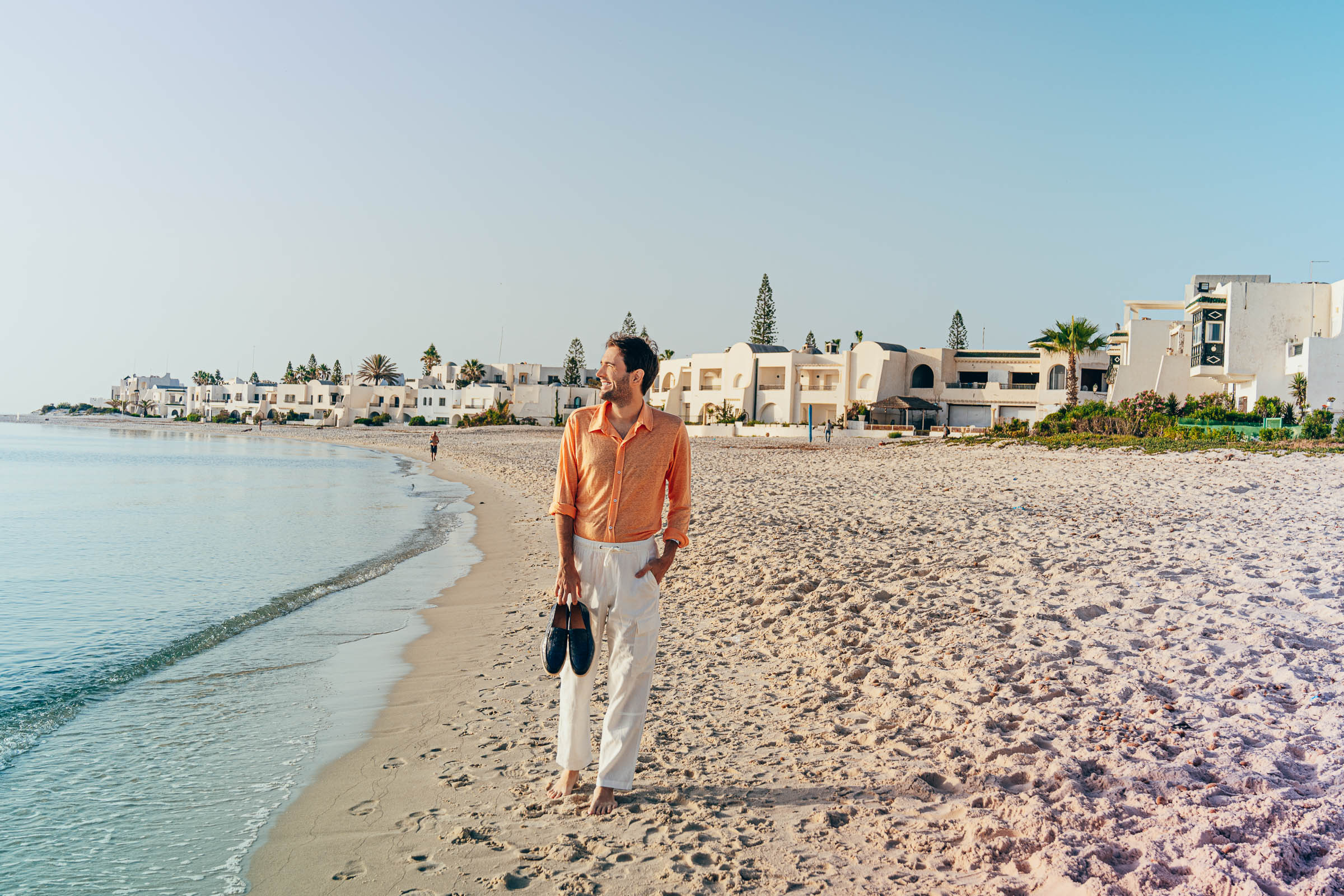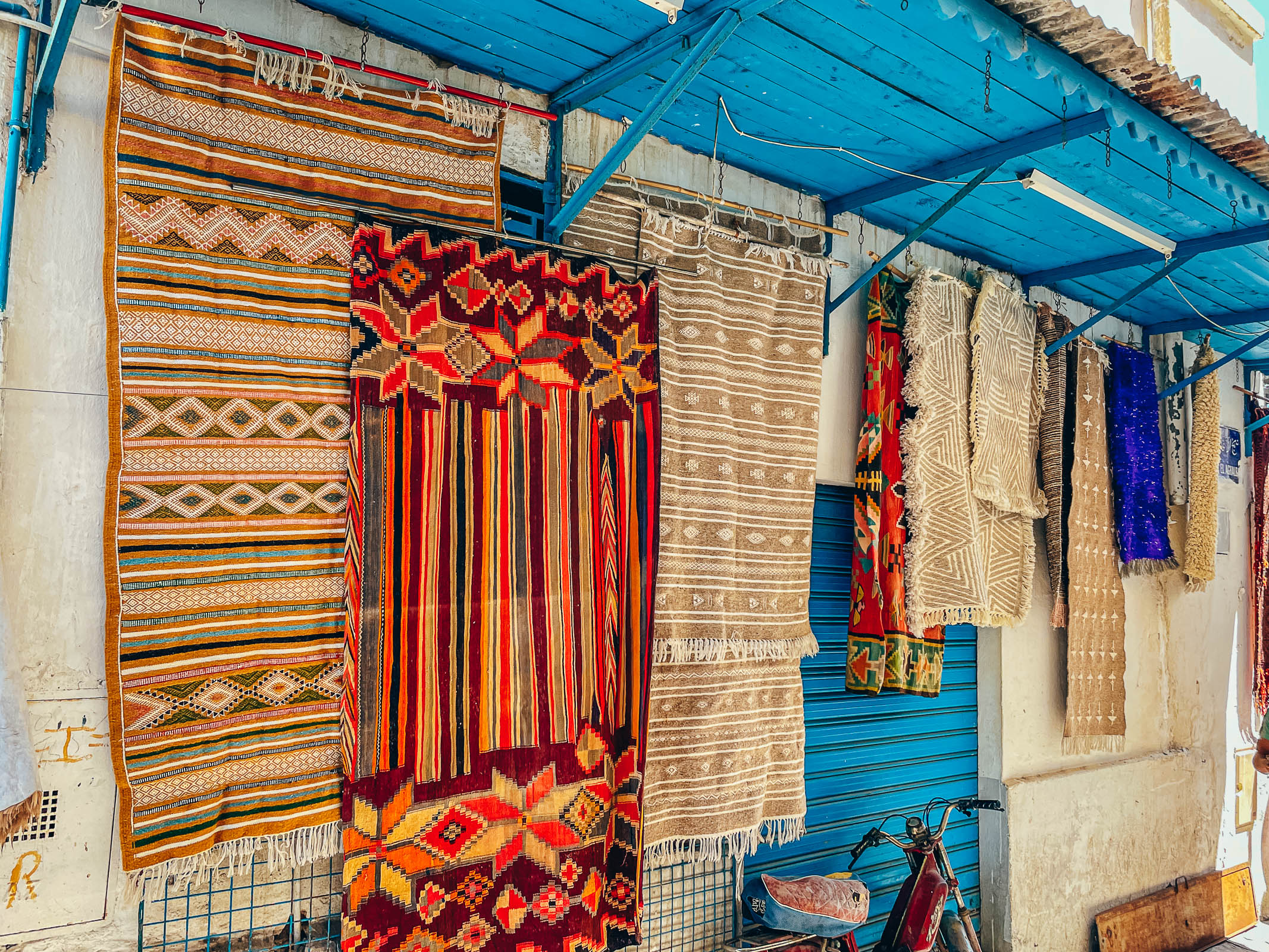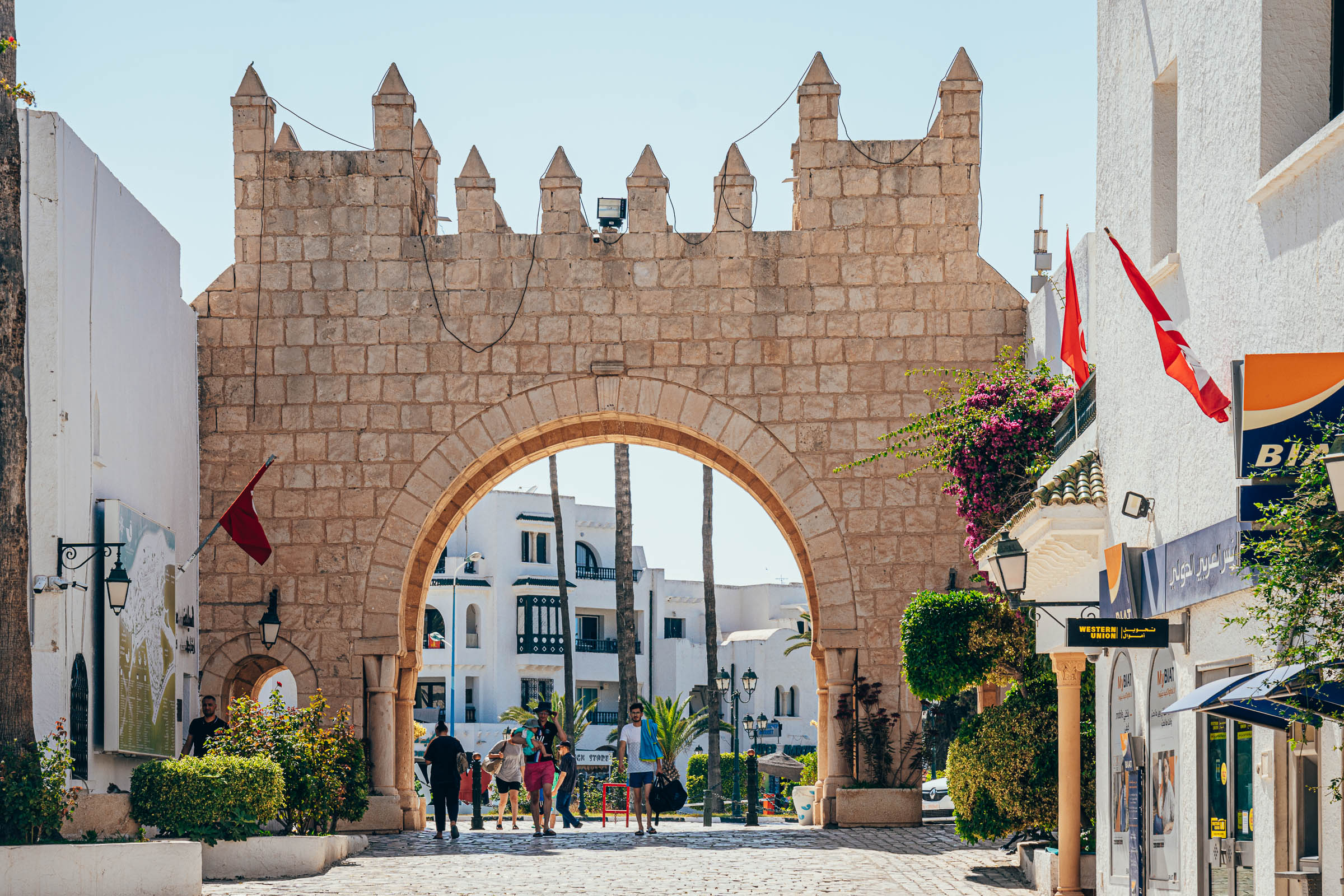My dear travellers and lovers of unusual trips, welcome to the new series of travelogues on the Mr.M blog. The month of July will be dedicated to an unusual country on the African continent – Tunisia, a country known for its olives. At the very beginning of this second post in the series of travelogues, I would like to thank the Ministry of Tourism of the Republic of Tunisia – Discover Tunisia for the warm invitation and hospitality. With their help, the travelogues and fashion stories that you will have the opportunity to read this July were created and I sincerely hope that you will enjoy them.
If by any chance you missed reading the previous travelogue from Tunisia or you want to remind yourself of some interesting things, take the opportunity to visit the following links:
- Letter from Tunisia: The Magnificent Amphitheater in El Jem…
- Aurélien: Refined Fashion in Sousse on the Mediterranean Coast… (fashion story)
The Republic of Tunisia is the northernmost country in Africa. It is part of the Maghreb region of North Africa, bordering Algeria to the west and southwest, Libya to the southeast, and the Mediterranean Sea to the north and east. It houses the archaeological sites of Carthage dating back to the 9th century BC, as well as the Great Mosque of Kairouan.
Tunisia is known for its ancient architecture, markets and blue shores, it covers approximately 164,000 km2 and has a population of around 12 million. It contains the eastern end of the Atlas Mountains and the northern part of the Sahara Desert, and much of the remaining territory of Tunisia is arable land. With almost 1,300 km of coastline, it includes the African junction of the western and eastern parts of the Mediterranean basin. Tunisia is home to the northernmost point of Africa – Cape Angel, and its capital and largest city is Tunis, located on its northeastern coast, after which the country gets its name.
The second blog post in the series of travelogues about Tunisia will be dedicated to the city of Sousse and Port el Kantaoui, which represent the true beauties of the African Mediterranean. Sousse is a port city in eastern Tunisia, located 143 kilometers south of Tunis, open to the Gulf of Hammamet in the Mediterranean Sea. The capital of the Tunisian Sahel – sometimes called the “pearl of the Sahel” and the capital of the governor of the same name, it is the third municipality in the country after Tunis and Sfax and the fourth agglomeration, Nabul is the third. Medina in Sousse has been on the UNESCO World Heritage List since 1988.
Similar city names can be found in Libya and southern Morocco, such as the Sousse region. Souss in Moroccan is synonymous with rief, which means nomads or village dwellers in general. However, the term Sous is here attributed to the city, which at that time was a symbol of power and sedentarism.
The municipality of Sousse is the capital of the province, which covers an area of 2,669 square kilometers. It is divided into four municipal districts: Sousse North, Sousse South, Sousse Medina and Sousse Riadh. The first two were founded on February 11, 1976, and the last two on February 19, 1982. Its main constituencies and delegations are four in number: Sousse Sidi Abdelhamid, Sousse Medina, Sousse Jawhara and Sousse Riadh.
I will tell you a little about the history of this unusual city. If the peoples of the sea (a people from ancient Egyptian history) undoubtedly settled earlier in the region of Susa, the Phoenicians are credited with the first known name of the city. In the eleventh century BC, the toponym Hadrim appears, indicating, according to M’hamed Hassine Fantar, an enclosure or a residential area. However, the archaeological remains of the site hardly date from the 6th century BC, the period when Hadrim came under the rule of Carthage and lived with it during the Punic War, retaining its Phoenician identity as evidenced by local burial customs. After losing the battle of Zama, Hannibal Barka, who had estates in the vicinity of Hadrim, forced his soldiers to perform civilian duties and started the planting of many olive trees in the area.
Hadrim gradually freed itself from Carthaginian influence by establishing direct economic and diplomatic relations with Rome, on whose side it sided during the Third Punic War. After the destruction of Carthage, the Hadrumetians became, according to Appian’s expression, “friends of the Roman people”, and the city, renamed Hadrumetum (Hadrumetum), became a privileged and free Roman city, enriched with the decorations of the Roman people. time visible even today.
Later in 46 B.C. she loses some of her privileges and receives a great punishment when she chooses the side of the Pompeians against the victorious Julius Caesar. At the end of the 1st century, Hadrumetum was the first African city to receive the status of an honorary colony granted by the emperor Trajan. As a sign of recognition, monuments are erected that glorify the generous emperor: a triumphal arch, a theater, an amphitheater, thermal baths, etc. The prosperity of the city reached its peak in the 3rd century during the reign of the Severan dynasty.
The trade in olive oil flourished after the founder of the dynasty established free and daily oil distribution in Rome. The city even mints its own currency. When in 238 the city supports the “usurper” Capellianus, it must be subjected to the repression of the new emperor Gordian II. Public monuments and mansions are being demolished, and the once active port is losing its importance. The city regained relative prosperity when, in 297, Emperor Diocletian made Hadrumetum the capital of the new province of Byzacene, which stretched across the center of the country.
When the Vandals expelled the Romans and destroyed the city walls in 439, Hadrumetum took the name Hunerikopolis, taken from the name of Hunericus (son of the Vandal chief Gensericus). Vegetated for a century before it was destroyed by marauders from the south of the country and just before the arrival of Byzantine troops. The port, completely cloudy, was rehabilitated by the Byzantine Emperor Justinian, whose name the city took in 535 (Justinianopolis) and became the capital of one of the seven provinces of the African Eparchy. The Byzantine period lasts about 135 years.
The beginning of the Arab-Muslim period can be said to start from the year 670, when Okba Ibn Nafi al-Fihri besieged the city which was named Susa. It is primarily an agglomeration that received a ribat in 787 and was populated mainly by ascetics in charge of coastal defense. The new development of Susa comes from the second Aglabid prince Ziadet-Allah I, who provided the city with a shipyard from which ships set out to conquer Sardinia, Malta, Sicily and Rome. In the 9th century, the city opened up and accepted Muslims, Christians and Jews. Then it becomes the second city of Ifrikiia and the first in the Sahel. During the Fatimid period, the prosperity of Susa suffered only moderately from the establishment of the Mahdiyya. The city, which exports its fabrics to the east and west, is also a prosperous olive-growing town.
By 1159, Sousse was attacked and then occupied by the Normans from Sicily who conquered it in 1148. But its decline, from the twelfth century, was mainly due to the promotion of Tunis as the capital under the Hafsid rule, the impoverishment of the hinterland whose seafaring represented a maritime outlet and in the thirteenth century, competition from textiles exported from Europe, the period during which the Genoese settled in Sousse. The city was subjected to a short Spanish occupation between 1537 and 1574. During the Ottoman era (1574-1881), the city regained its importance. At that time, in the 17th century, Sousse was the second trading port in the country.
In addition to embroiderers and weavers, there are also artisan potters who export their production throughout the Mediterranean basin. At the end of the 18th century, the city suffered from French (1770) and Venetian (1784 and 1786) bombardments. The city fell into decline after 1864 when it sided with Sadok Beg in a rebellion against taxes. It passed, like the whole of Tunisia, under the French protectorate from 1881. However, with the creation of a new port in 1884, the role of a maritime sales point for products from the steppe was restored.
The municipality of Sousse was founded on July 16, 1884. Since this date in the late 19th century, Sousse has seen the arrival and settlement of many Europeans, especially of French and Italian origin, who had to leave the country after its independence.
The eastern part of the medina is completed by the expanded port from 1899. Further north stretches the new town built under the French protectorate and is characterized by wide straight streets and a promenade overlooking the sea where the hotels are lined up towards Port El-Kantaoui. The Medina in Sousse, like the one in Tunisia, was classified as a UNESCO World Heritage Site in 1988. One of the elements that sets it apart is the location of the main mosque, which is not in the city center. Like the ribat, it was responsible for protecting the arsenal’s artificial pool, which explains its military appearance.
Ribat was originally a small fortress built in the early days of the Muslim conquest of the Maghreb to protect the city’s borders. The term also refers to places that are home to Sufis. Over time, they become lodges for travelers, but also refuges for mystics. In this sense, the ribats are perhaps the source of the first streams of Sufism. In this sense, we can assimilate these places with zaouias. A marabout, a term used indiscriminately in North Africa to refer to saints, tribal chiefs and folk healers, is therefore someone who lives in a ribat.
Ribat was created during the reign of the Aghlabid dynasty, but after the construction of the city walls in 859, it gradually lost its military function. While there is a small mosque on the first floor, the basement has been converted into various rooms and warehouses, while traces of the olive press remain. The imposing entrance, flanked by two columns in the Corinthian style, was designed as a double door, which served to block access to the fortress. As for the Kasbah, it is located in the highest part of the medina and dates back to the year 844. In 853, the 30-meter-high lighthouse was named after the eunuch of the Aglabid sovereign Ziadet-Allah I (Khalaf El Fata). Since 1951, the Archaeological Museum in Sus has been housed in its walls.
The Souq in Sousse is amazing, a tangle of alleys where you can find everything from interesting souvenirs to jewelry made of semi-precious and precious stones, as well as jewelry made of precious metals. Of course, the market in Sousse has a rich selection of clothes and shoes that you can easily fit into your style and bring the spirit of North African fashion into your wardrobe.
For lovers of handicrafts, pottery and home items, here you can find a lot of interesting pieces with which you can beautify and enrich your living space. As for the prices, as in every market and bazaar there is the possibility of haggling, so you can show and practice your negotiation skills.
Port El-Kantaoui is a marina located northwest of the city of Sousse, which has become one of the most important seaside resorts of Tunisia. The project to create an integrated tourist resort on 307 hectares stems from the idea of Tunisian President Habib Bourguiba, who wants to develop tourism in the Sahel region.
It was studied in 1971 by the Tunisian tourist finance company in the area of Sidi El-Kantaoui, which is located in the territory of the Hammam Sousse municipality, north of Sousse. It is up to the Societe d’etudes et de developpement de Sousse-Nord to study the economic and financial possibilities of the project and to assume the role of general promoter. When work began under the direction of Olivier-Clement Cacoub, the port was excavated and small residential buildings (Maisons de la Mer) were built around its perimeter. The hotel complex is a structure that marks the entrance to the port. The port was opened in 1979 and the Societe hoteliere et tourisme du Port El-Kantaoui delegated the task of developing and managing the resort to the Societe d’etudes et de developpement de Sousse-Nord.
An 18-hole golf course was installed in 1980 on 130 hectares on the hillside, and in the late 1990s, the land occupied by the parking lot at the entrance to the harbor allowed the complex to be expanded by construction. a new district (Houses of the Gardens) and a permanent fairground (Hannibal Park) that allows diversification of the activities offered in free time. Three to five star hotels are being built around the complex and along the coast towards Chott Meriem in the north and Hammam Sousse in the south.
The port is a real village, mostly pedestrian, built according to an architecture reminiscent of the village of Sidi Bou Said in its Arabic-Moorish style, the whiteness of its walls, arcades, arches and alleys decorated with flowers. The resort has many shops, including restaurants, cafes and shops for foreign tourists who visit the place for its seven kilometers of beach. In addition, during the summer period, the port hosts many events, including the International Summer Internet Festival, regattas, music stages and numerous other activities.
These riches also attract many Sahelians who come to relax a bit during weekends or holidays. The construction of Yasmina Hammamet in the early 2000s did not cause a decline in attendance. The harbor can accommodate up to 340 boats on a total area of four hectares.
My dear adventurers, we have come to the end of this second special travelogue in the series of travelogues about Tunisia where we had the opportunity to enjoy the beauty of this unusual country in the northern part of the African continent. Today’s travelogue would not be possible without the selfless help of the Ministry of Tourism of the Republic of Tunisia – Discover Tunisia in cooperation with local partners who allowed me to feel the spirit and beauty of Tunisian culture and tradition. Of course, as always, I tried my best to convey to you my impressions of this unusual experience from Tunisia.
A person is rich in soul if he has managed to explore the world and I am glad that I always manage to find partners of my projects who help me to discover new and unusual destinations in a completely different way.
I am honored to have the opportunity to collaborate with companies that are the very top of the tourism industry and I would like to thank the Ministry of Tourism of the Republic of Tunisia once again for this incredible adventure and for allowing me to experience the beauty of this unusual Tunisian culture in a completely different way.
How did you like my story about Tunisia and the presentation of Sousse and Port El Kantaoui that adorns the heart of this unusual country on the African continent? Have you had the chance to visit Tunisia so far?
If you have any question, comment, suggestion or message for me you can write me below in the comments. Of course, as always, you can contact me via email or social networks, all addresses can be found on the CONTACT page. See you at the same place in a few days, with some new story!
In the following stories from Tunisia, we will discover some other interesting sights that you should visit if your journey takes you to this far-flung, unusual country!
From Love from Sousse,
Mr.M
This post is sponsored by the Ministry of Tourism of the Republic of Tunisia – Discover Tunisia, as well as other local partners. This post is my personal and honest review of the destination experience.





























Beautiful pictures from sunny Sousse, looks like a lovely place! I’ve been vacationing in Egypt for many years, I honestly didn’t think about Tunisia, but I’ll look into some arrangements for Tunisia since I was thinking of using my vacation in August to go somewhere to travel.
Is September or October the right time to vacation in Tunisia? Can people bathe even then? It looks wonderful, but I always have later dates for my vacation due to the nature of my work, so I can’t go on vacation earlier.
Tunisia is a great holiday destination and there is a lot to visit. I look forward to your next stories to see what can be visited, as I am currently considering with my family whether it is better to go to Tunisia or Morocco for a vacation.